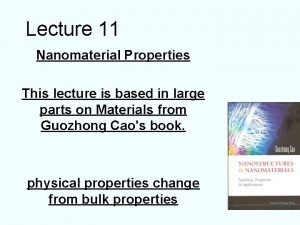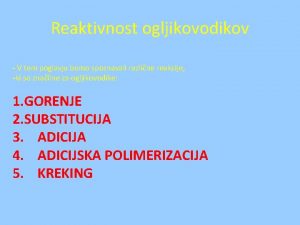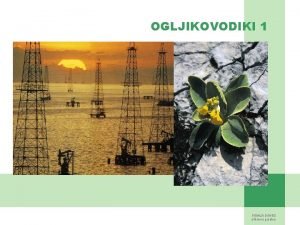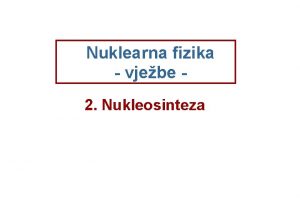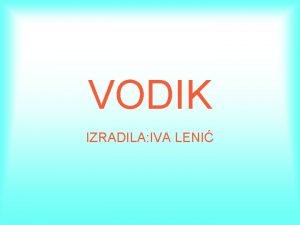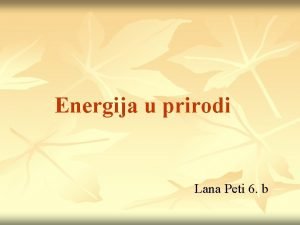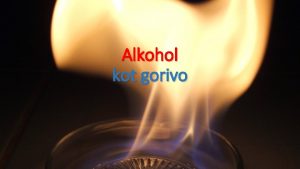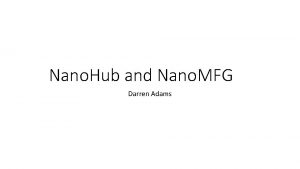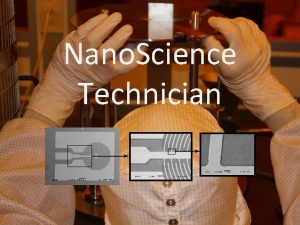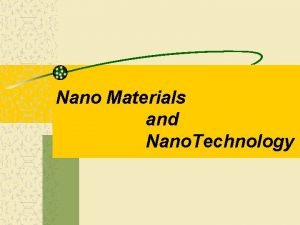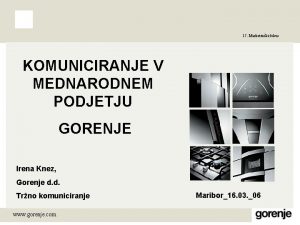Nano materials and industrial production of Gorenje large













- Slides: 13

Nano materials and industrial production of Gorenje large domestic appliances Dr. Aleš Mihelič & Boštjan Bavec Brussels, March 2017 1

One of Leading European Manufacturers of Products for Home CORE BUSINESS Products and services for home (MDA, SDA, HVAC, kitchen furniture) R&D COMPETENCE CENTRES Slovenia Czech Republic Sweden Netherlands Gorenje Group NUMBER OF EMPLOYEES 10, 796 CONSOLIDATED REVENUE EUR 1. 257 billion EXPORT 95% of sales MDA (major domestic appliances) SDA (small domestic appliances) HVAC (heating, ventilation, air conditioning) 2 OWN PRODUCTION Slovenia Serbia Czech Republic GLOBAL PRESENCE 90 Countries Worldwide, mostly in Europe (92%), also in USA, Australia, Near and Far East

Most Important Markets: Germany, Russia and the Netherlands GERMANY RUSSIA THE NETHERLANDS SERBIA SLOVENIA CZECH REPUBLIC CROATIA DENMARK AUSTRALIJA USA UKRAINE BIH AUSTRIA POLAND BELGIUM HUNGARY FINLAND NORWAY RUMANIA SLOVAKIA SWEDEN BULGARIA GREAT BRITAIN FRANCE MONTENEGRO 3

Gorenje Group Brand Portfolio Implementing a multi-brand strategy with attention on the upper-mid and premium price segment. 4

Vision, Mission, Corporate Values 5

Material which are used nowadays in regular Gorenje production - Different quality of steel (decarburized steel, low alloyed different quality of stainless steel) - Enamels (white, black, gray…) - Glass - Plastic - Rubber - Wire - Different surface protecting coatings 6

The main shortcomings of regular materials are • Corrosion • Appearance of bacteria if costumer don’t clean it regularly 7 • Hard to clean oil from enamels • Glass can have fog appearance • Scratches on surface • Lose off color shine • Energy losses

WHAT ARE NANOMATERIAL 8

Which material are used for nanomaterial now days • Carbon black • Silica fumes • Clay • Metal/alloys • Ceramics Used in tires and other rubber products, fillers, pigments, synthetic bone, polishing slurries, pharma additives, sun 9

Main advantages why to use nano material in home appliance Nano material allow to achieve amazing things; antibacterial protection self-cleaning effect surfaces can make them water- and residue-repellent resistant to ultraviolet or infrared light good corrosion protection different color visibly anti wear protection and scratch-resistant antifog energy reflection 10

Where would be most visible advantage with build in nanomaterials 11 - Less energy consumptions we could achieve higher energy level A+++… - Anti/Less bacteria - Less material in appliances (lower weight) - More resistant to scratch (we would be able to sell coking appliance without enamels - Oleofobic materials - almost no need to clean - Feel like metal plastic - Innovative displays - …

The main problems in implementing nanotechnology in production • • Liability for product during whole lifetime Workers working environment Difficult to recycle Legislation barriers One sweat pore 12

Thank you for your attention 13
 Pre production production post production
Pre production production post production Hardness of nanomaterials
Hardness of nanomaterials Adicija broma
Adicija broma Heksan strukturna formula
Heksan strukturna formula Gorenje helija
Gorenje helija Gorenje vodika jednadžba
Gorenje vodika jednadžba Gorenje parafina
Gorenje parafina Energija u prirodi
Energija u prirodi Enačba za alkoholno vrenje
Enačba za alkoholno vrenje Cant stop the feeling trolls go noodle
Cant stop the feeling trolls go noodle Ano ang mga useful materials
Ano ang mga useful materials Natural man made
Natural man made Differentiate adopting materials and adapting materials
Differentiate adopting materials and adapting materials Index of industrial production formula
Index of industrial production formula

